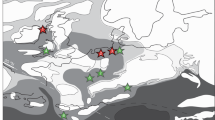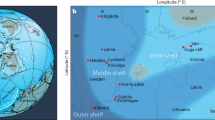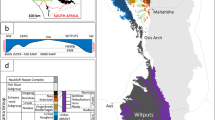Abstract
Marine redox conditions (that is, oxygen levels) impact a wide array of biogeochemical cycles, but the main controls of marine redox since the start of the Phanerozoic about 538 million years ago are not well established. Here we combine supervised machine learning with shale-hosted trace metal concentrations to reconstruct a near-continuous record of redox conditions in major marine depositional settings. We find synchronously opposite redox changes in upper ocean versus deep shelf and (semi-)restricted basin settings ('redox anticouples', nomen novum) in several multi-million-year intervals, which can be used to track the positions of oxygen-minimum zones and the primary locations of organic burial through time. These changes coincided with biological innovations that altered large-scale oxidant-reductant fluxes (mid-Palaeozoic spread of land plants; Mesozoic plankton revolution) and tectonic upheavals that regulated sea-level elevation (Pangaea amalgamation and break-up). We find that the pre-Devonian deep shelf was buffered at a largely anoxic state probably by dissolved organic matter, switched to a transitional state during the Devonian–Carboniferous interval characterized by the inception of persistent oxygen-minimum zones and subsequently shifted to a redox regime featuring thin oxygen-minimum zones ballasted probably by particulate organic matter. Deep shelf redox changes are correlated with background extinction rates of marine animals, and mass extinctions during major redox transitions generally were more severe.
This is a preview of subscription content, access via your institution
Access options
Access Nature and 54 other Nature Portfolio journals
Get Nature+, our best-value online-access subscription
$29.99 / 30 days
cancel any time
Subscribe to this journal
Receive 12 print issues and online access
$259.00 per year
only $21.58 per issue
Buy this article
- Purchase on Springer Link
- Instant access to full article PDF
Prices may be subject to local taxes which are calculated during checkout




Similar content being viewed by others
Data availability
All data needed to evaluate the conclusions of the manuscript are archived as Supplementary Data Files associated with the online version of this article and also available at figshare (https://doi.org/10.6084/m9.figshare.24139617).
Code availability
Python code for machine learning is archived as supplementary code files associated with the online version of this article and is also available at figshare (https://doi.org/10.6084/m9.figshare.24139617).
References
Lyons, T. W., Reinhard, C. T. & Planavsky, N. J. The rise of oxygen in Earth’s early ocean and atmosphere. Nature 506, 307–315 (2014).
Kopp, R. E., Kirschvink, J. L., Hilburn, I. A. & Nash, C. Z. The Paleoproterozoic snowball Earth: a climate disaster triggered by the evolution of oxygenic photosynthesis. Proc. Natl Acad. Sci. USA 102, 11131–11136 (2005).
Sperling, E. A. et al. A long-term record of early to mid-Paleozoic marine redox change. Sci. Adv. 7, eabf4382 (2021).
Sperling, E. A. et al. Statistical analysis of iron geochemical data suggests limited late Proterozoic oxygenation. Nature 523, 451–454 (2015).
Emmings, J. F. et al. Pyrite mega-analysis reveals modes of anoxia through geological time. Sci. Adv. 8, eabj5687 (2022).
Pohl, A. et al. Continental configuration controls ocean oxygenation during the Phanerozoic. Nature 608, 523–527 (2022).
Meyer, K. M. & Kump, L. R. Oceanic euxinia in Earth history: causes and consequences. Annu. Rev. Earth Planet. Sci. 36, 251–288 (2008).
Poulton, S. W. & Canfield, D. E. Development of a sequential extraction procedure for iron: implications for iron partitioning in continentally derived particulates. Chem. Geol. 214, 209–221 (2005).
Little, S. H., Vance, D., Lyons, T. W. & McManus, J. Controls on trace metal authigenic enrichment in reducing sediments: insights from modern oxygen-deficient settings. Am. J. Sci. 315, 77–119 (2015).
Bennett, W. W. & Canfield, D. E. Redox-sensitive trace metals as paleoredox proxies: a review and analysis of data from modern sediments. Earth Sci. Rev. 204, 103175 (2020).
Lu, W. et al. Late inception of a resiliently oxygenated upper ocean. Science 361, 174–177 (2018).
Berner, R. A. GEOCARBSULF: a combined model for Phanerozoic atmospheric O2 and CO2. Geochim. Cosmochim. Acta 70, 5653–5664 (2006).
Young, A. et al. Long-term Phanerozoic sea level change from solid Earth processes. Earth Planet. Sci. Lett. 584, 117451 (2022).
Lenton, T. M. et al. First plants cooled the Ordovician. Nat. Geosci. 5, 86–89 (2012).
Lenton, T. M., Daines, S. J. & Mills, B. J. COPSE reloaded: an improved model of biogeochemical cycling over Phanerozoic time. Earth Sci. Rev. 178, 1–28 (2018).
Algeo, T. J. & Scheckler, S. E. Terrestrial-marine teleconnections in the Devonian: links between the evolution of land plants, weathering processes, and marine anoxic events. Philos. Trans. R. Soc. London B 353, 113–130 (1998).
Lenton, T. M. et al. Earliest land plants created modern levels of atmospheric oxygen. Proc. Natl Acad. Sci. USA 113, 9704–9709 (2016).
Liu, Y. et al. Elevated marine productivity triggered nitrogen limitation on the Yangtze Platform (South China) during the Ordovician–Silurian transition. Palaeogeogr. Palaeoclimatol. Palaeoecol. 554, 109833 (2020).
Stramma, L., Schmidtko, S., Levin, L. A. & Johnson, G. C. Ocean oxygen minima expansions and their biological impacts. Deep-Sea Res. I 57, 587–595 (2010).
Li, N. et al. Redox changes in the outer Yangtze Sea (South China) through the Hirnantian Glaciation and their implications for the end-Ordovician biocrisis. Earth Sci. Rev. 212, 103443 (2021).
Zhang, L. et al. Persistent oxic deep ocean conditions and frequent volcanic activities during the Frasnian–Famennian transition recorded in South China. Glob. Planet. Change 195, 103350 (2020).
Joachimski, M. M. & Buggisch, W. Anoxic events in the late Frasnian—causes of the Frasnian–Famennian faunal crisis? Geology 21, 675–678 (1993).
Chen, B. et al. Was climatic cooling during the earliest Carboniferous driven by expansion of seed plants? Earth Planet. Sci. Lett. 565, 116953 (2021).
Berner, R. A. & Canfield, D. E. A new model for atmospheric oxygen over Phanerozoic time. Am. J. Sci. 289, 333–361 (1989).
Royer, D. L. in Treatise on Geochemistry 2nd edn (eds Holland, H. D. & Turekian, K. K.) 251–267 (Elsevier, 2014).
Liu, J., Algeo, T. J., Qie, W. & Saltzman, M. R. Intensified oceanic circulation during Early Carboniferous cooling events: evidence from carbon and nitrogen isotopes. Palaeogeogr. Palaeoclimatol. Palaeoecol. 531, 108962 (2019).
Hull, P. M. Emergence of modern marine ecosystems. Curr. Biol. 27, R466–R469 (2017).
Falkowski, P. G. et al. The evolution of modern eukaryotic phytoplankton. Science 305, 354–360 (2004).
Meyer, K. M., Ridgwell, A. & Payne, J. The influence of the biological pump on ocean chemistry: implications for long‐term trends in marine redox chemistry, the global carbon cycle, and marine animal ecosystems. Geobiology 14, 207–219 (2016).
Poulton, S. W. & Canfield, D. E. Ferruginous conditions: a dominant feature of the ocean through Earth’s history. Elements 7, 107–112 (2011).
Li, C. et al. The redox structure of Ediacaran and early Cambrian oceans and its controls. Sci. Bull. 65, 2141–2149 (2020).
Leavitt, W. D., Halevy, I., Bradley, A. S. & Johnston, D. T. Influence of sulfate reduction rates on the Phanerozoic sulfur isotope record. Proc. Natl Acad. Sci. USA 110, 11244–11249 (2013).
Reinhard, C. T. et al. Earth’s oxygen cycle and the evolution of animal life. Proc. Natl Acad. Sci. USA 113, 8933–8938 (2016).
Li, C., Cheng, M., Zhu, M. & Lyons, T. W. Heterogeneous and dynamic marine shelf oxygenation and coupled early animal evolution. Emerg. Top. Life Sci. 2, 279–288 (2018).
Bopp, L. et al. Potential impact of climate change on marine export production. Glob. Biogeochem. Cycles 15, 81–99 (2001).
Spiridonov, A. & Lovejoy, S. Life rather than climate influences diversity at scales greater than 40 million years. Nature 607, 307–312 (2022).
Finnegan, S., Payne, J. L. & Wang, S. C. The Red Queen revisited: reevaluating the age selectivity of Phanerozoic marine genus extinctions. Paleobiology 34, 318–341 (2008).
Peters, S. E. Environmental determinants of extinction selectivity in the fossil record. Nature 454, 626–629 (2008).
Stockey, R. G. et al. Decreasing Phanerozoic extinction intensity as a consequence of Earth surface oxygenation and metazoan ecophysiology. Proc. Natl Acad. Sci. USA 118, e2101900118 (2021).
Shi, W. et al. Decoupled oxygenation of the Ediacaran ocean and atmosphere during the rise of early animals. Earth Planet. Sci. Lett. 591, 117619 (2022).
MacKenzie, F. T. & Andersson, A. J. The marine carbon system and ocean acidification during Phanerozoic time. Geochem. Perspect. 2, 1–3 (2013).
Song, H. et al. Thresholds of temperature change for mass extinctions. Nat. Comm. 12, 4694 (2021).
Ronov, A. B. Phanerozoic transgressions and regressions on the continents; a quantitative approach based on areas flooded by the sea and areas of marine and continental deposition. Am. J. Sci. 294, 777–801 (1994).
Hallam, A. & Wignall, P. Mass extinctions and sea-level changes. Earth Sci. Rev. 48, 217–250 (1999).
Bond, D. P. & Wignall, P. B. in Volcanism, Impacts and Mass Extinctions: Causes and Effects (eds Keller, G. & Kerr, A. C.) 29–55 (Geological Society of America, 2014).
Raup, D. M. & Sepkoski, J. J. Jr Mass extinctions in the marine fossil record. Science 215, 1501–1503 (1982).
Foote, M. Origination and extinction components of taxonomic diversity: general problems. Paleobiology 26, 74–102 (2000).
Alroy, J. Dynamics of origination and extinction in the marine fossil record. Proc. Natl Acad. Sci. USA 105, 11536–11542 (2008).
D’Antonio, M. P., Ibarra, D. E. & Boyce, C. K. Land plant evolution decreased, rather than increased, weathering rates. Geology 48, 29–33 (2020).
Martin, R. E. Cyclic and secular variation in microfossil biomineralization: clues to the biogeochemical evolution of Phanerozoic oceans. Glob. Planet. Change 11, 1–23 (1995).
Cooper, R. A., Sadler, P. M., Munnecke, A. & Crampton, J. S. Graptoloid evolutionary rates track Ordovician–Silurian global climate change. Geol. Mag. 151, 349–364 (2014).
Vérard, C. & Veizer, J. On plate tectonics and ocean temperatures. Geology 47, 881–885 (2019).
Foster, G. L., Royer, D. L. & Lunt, D. J. Future climate forcing potentially without precedent in the last 420 million years. Nat. Comm. 8, 14845 (2017).
Grossman, E. L. & Joachimski, M. M. Ocean temperatures through the Phanerozoic reassessed. Sci. Rep. 12, 8938 (2022).
Farrell, Ú. C. et al. The sedimentary geochemistry and paleoenvironments project. Geobiology 19, 545–556 (2021).
Algeo, T. J. & Liu, J. A re-assessment of elemental proxies for paleoredox analysis. Chem. Geol. 540, 119549 (2020).
Van der Weijden, C. H. Pitfalls of normalization of marine geochemical data using a common divisor. Mar. Geol. 184, 167–187 (2002).
Aitchison, J. The statistical analysis of compositional data. J. R. Stat. Soc. Ser. B 44, 139–160 (1982).
Sadler, P. M. Sediment accumulation rates and the completeness of stratigraphic sections. J. Geol. 89, 569–584 (1981).
Crombez, V. et al. Trace metal elements as paleoenvironmental proxies: why should we account for sedimentation rate variations? Geology 48, 839–843 (2020).
Algeo, T. J. Can marine anoxic events draw down the trace element inventory of seawater? Geology 32, 1057–1060 (2004).
McArthur, J. M., Howarth, R. & Bailey, T. Strontium isotope stratigraphy: LOWESS version 3: best fit to the marine Sr-isotope curve for 0–509 Ma and accompanying look-up table for deriving numerical age. J. Geol. 109, 155–170 (2001).
Condie, K. C. Chemical composition and evolution of the upper continental crust: contrasting results from surface samples and shales. Chem. Geol. 104, 1–37 (1993).
Kump, L. R., Bralower, T. J. & Ridgwell, A. Ocean acidification in deep time. Oceanography 22, 94–107 (2009).
Li, C. et al. Coupled oceanic oxygenation and metazoan diversification during the Early–Middle Cambrian? Geology 45, 743–746 (2017).
Edwards, C. T., Saltzman, M. R., Royer, D. L. & Fike, D. A. Oxygenation as a driver of the Great Ordovician Biodiversification Event. Nat. Geosci. 10, 925–929 (2017).
Zheng, Y., Anderson, R. F., van Geen, A. & Fleisher, M. Q. Preservation of particulate non-lithogenic uranium in marine sediments. Geochim. Cosmochim. Acta 66, 3085–3092 (2002).
Keller, C. B. & Schoene, B. Statistical geochemistry reveals disruption in secular lithospheric evolution about 2.5 Gyr ago. Nature 485, 490–493 (2012).
Puttiwongrak, A., Giao, P. H. & Vann, S. An easily used mathematical model of porosity change with depth and geologic time in deep shale compaction. GEOMATE J. 19, 108–115 (2020).
Shipboard Scientific Party in Deep Sea Drilling Project: Initial report Vol. 15 (eds Edgar, N. T. et al.) 169–215 (Deep Sea Drilling Project, 1973).
Shipboard Scientific Party in Proceedings of the Ocean Drilling Program, Initial Report Vol. 165 (eds Sigurdsson H. et al.) 359–373 (Ocean Drilling Program, 1997).
Acknowledgements
This research was supported by the National Natural Science Foundation of China (41888101 to X.W., C.L. and M.Z.; 42293293 to X.W.; 41921002 to M.Z.; 41821001, 41825019, 42130208 to C.L.), the National Key Research and Development Program of China (2022YFF0800100 to M.Z.; 2020YFA0607700 to X.W.) and the 111 Project of China (BP0820004 to C.L.). We gratefully acknowledge J. F. Emmings for constructive comments during review.
Author information
Authors and Affiliations
Contributions
Research design: X.W, C.L. Methodology: X.W. Validation: X.W., T.J.A. Investigation: X.W., T.J.A., C.L., M.Z. Data curation: X.W., T.J.A. Visualization: X.W. Supervision: X.W. Writing, original draft: X.W. Writing, review and editing: X.W., T.J.A., C.L., M.Z.
Corresponding authors
Ethics declarations
Competing interests
The authors declare no competing interests.
Peer review
Peer review information
Nature Geoscience thanks Joseph Emmings and Frantz Ossa Ossa for their contribution to the peer review of this work. Primary Handling Editor(s): James Super, in collaboration with the Nature Geoscience team.
Additional information
Publisher’s note Springer Nature remains neutral with regard to jurisdictional claims in published maps and institutional affiliations.
Extended data
Extended Data Fig. 1 Map of sample locations.
Sample locations.
Extended Data Fig. 2 Paleo-map of reconstructed F′CPOMZ.
Paleogeographic distribution of F′CPOMZ (value represented by the color bar). See definition and calculation of F′CPOMZ in the main text. Reconstruction of tectonic configuration and conversion of coordinates were performed using GPlates PALEOMAP PaleoAtlas35.
Extended Data Fig. 3 Paleo-map of reconstructed F′P-Euxinic.
Paleogeographic distribution of F′P-Euxinic (value represented by the color bar). See definition and calculation of F′P-Euxinic in the main text. Reconstruction of tectonic configuration and conversion of coordinates were performed using GPlates PALEOMAP PaleoAtlas35.
Extended Data Fig. 4 Paleo-map of reconstructed FCPOMZ.
Paleogeographic distribution of FCPOMZ (value represented by the color bar). See definition and calculation of FCPOMZ in the main text. Reconstruction of tectonic configuration and conversion of coordinates were performed using GPlates PALEOMAP PaleoAtlas35.
Extended Data Fig. 5 Paleo-map of reconstructed FP-Euxinic.
Paleogeographic distribution of FP-Euxinic (value represented by the color bar). See definition and calculation of FP-Euxinic in the main text. Reconstruction of tectonic configuration and conversion of coordinates were performed using GPlates.
Extended Data Fig. 6 Paleo-map of reconstructed FBPOMZ.
Paleogeographic distribution of FBPOMZ (value represented by the color bar). See definition and calculation of FBPOMZ in the main text. Reconstruction of tectonic configuration and conversion of coordinates were performed using GPlates PALEOMAP PaleoAtlas35.
Extended Data Fig. 7 Paleo-map of reconstructed FS-Euxinic.
Paleogeographic distribution of FS-Euxinic (value represented by the color bar). See definition and calculation of FS-Euxinic in the main text. Reconstruction of tectonic configuration and conversion of coordinates were performed using GPlates PALEOMAP PaleoAtlas35.
Extended Data Fig. 8 Secular evolution of Fe/Al, Mo/Al, U/Al and V/Al in Phanerozoic shales.
Secular evolution of Fe/Al (wt%/wt%), Mo/Al (ppm/wt%), U/Al (ppm/wt%) and V/Al (ppm/wt%) in Phanerozoic shales. Markers and error bars represent medians and 2SDs of 10,000 bootstrap resampling from spatiotemporally reweighted database (see Materials and Methods). Curves and bands are LOWESS fittings (smoothing factors optimized by 10-fold cross-validation) and prediction intervals (2σ). Raw data are represented by gray dots. Note that y-axes are cropped and thus some raw data fall outside of the graphs.
Supplementary information
Supplementary Data
Data used in this article.
Supplementary Code
Python code used for data analysis in this article.
Rights and permissions
Springer Nature or its licensor (e.g. a society or other partner) holds exclusive rights to this article under a publishing agreement with the author(s) or other rightsholder(s); author self-archiving of the accepted manuscript version of this article is solely governed by the terms of such publishing agreement and applicable law.
About this article
Cite this article
Wang, X., Algeo, T.J., Li, C. et al. Spatial pattern of marine oxygenation set by tectonic and ecological drivers over the Phanerozoic. Nat. Geosci. 16, 1020–1026 (2023). https://doi.org/10.1038/s41561-023-01296-y
Received:
Accepted:
Published:
Issue Date:
DOI: https://doi.org/10.1038/s41561-023-01296-y



